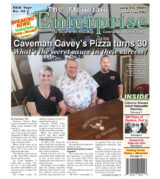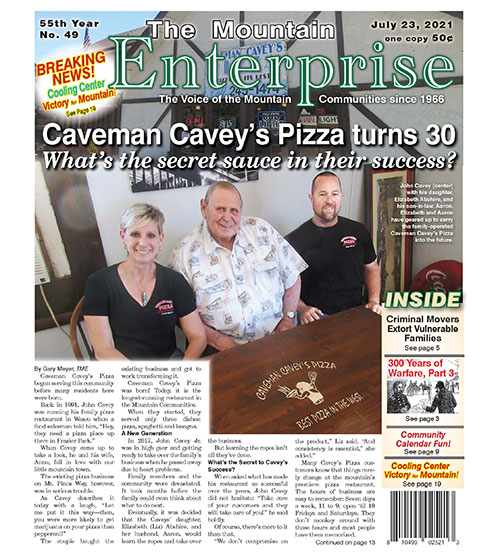By Marcy Axness, with Patric Hedlund,TME
Last week’s Bear fire was a frightening wake-up call to some Lebec neighbors.
How about you? Are you prepared for a quick evacuation?
Preparing Is Ongoing
Think about evacuation preparation as an ongoing process rather than a paralyzing one-time chore we must nail on the first try. Most important: Begin today.
To Do Right Now
•Photograph or scan critical items such as real estate deeds, home/fire insurance policies, which will help with insurance and FEMA claims. Put the data on an external drive to keep with you and upload to the cloud;
•Make a list of all bank, credit card and brokerage accounts, with account numbers and company contact information, then add to your flash drive; print out; and email to your cloud-based account;
•Photograph or video the contents of each room in your house, opening cabinets, closets and drawers to show important items. Save that to cloud / drive.
Make Your Family Plan
•As a household, make a plan that everyone is clear about, based upon “where you’re going to go at 1 a.m.,” suggested Sergeant Kevin Kimmel, formerly of our local sheriff’s substation. He uses the 1 a.m. scenario because “these things always seem to happen at the most inopportune time.”
•Everyone should be clear about such basic plans as, “If you can see flames to the east, we’re going to go west.”
•Agree on out-of-town family or friends to call as a contact hub.
Pack Your Go Bags
Put together a Go Bag for each person, and your pets, with items you will need for a 72-hour period.
•Include extra glasses or contacts;
•medications;
• toiletries and hygiene items;
•phone chargers;
•flash drives and contact lists;
•change of underwear, socks and clothes;
•change of walking shoes, plus walking stick if used;
•pet carrier, leash, pet food;
•can opener, utensils, knife;
•and have plenty of jugs of water in the car, plus pet bowl.
The Time-Tiered List
In emergency conditions, the reasoning systems of our brains can be impaired by fight-or-flight responses.
Make a clear list to follow in advance, so you won’t resort to a haphazard panic grab.
Your goal: Save key things of value—both monetary and sentimental.
•No-Time Tier
This includes the people, pets and your most urgent items already packed in your Go Bag, for when you must leave immediately, with no advance notice. Your Go Bag is at the top of the list
•10-Minutes Tier
Here is my list. It includes items noted above, plus: •Laptop and device charging cords;
•Dental night guard and earplugs;
•Medications not in Go Bag, passport, Social Security card, cash, shoes with orthotics; and my (always packed) travel toilet articles kit.
•30-Minute Tier
All previous items are included, plus next-priorities that can be loaded in 30 minutes. My list includes jewelry, vitamin supplements, backup drive and my precious, irreplaceable recipe box.
•chain saw (for trees blocking exit roads);
•extra gas (for chain saw or car);
•fire extinguishers.
What Matters Most
Time is what matters most. The real value of your evacuation list comes in starting that list long before it is needed.
Once you begin this process, you will continue to think of new items to include in various tiers.
Continue refining the list. Print out a current copy to keep in a prominent location, like the refrigerator.
If you use a word processing program you can continue to revise and print it out.
Having this list in hand can bring great peace of mind. The Readiness Mindset will help you be confident if you get the alert that it is time to leave to let the firefighters do their work.
•If You Have An Hour
First, load your car and be sure everyone is ready to leave and pets are in their pet carriers inside the vehicle.
•Then prepare your home to resist fire in your absence.
•Turn off the gas to your house.
•Close all windows and curtains.
•Close the doors to all rooms.
•Remove everything that is flammable from your decks, and stash them inside.
•Unplug appliances.
•If you turn off the water to your house to prevent flooding should a pipe break in your absence, CalFire advises that we may wish to place full water buckets around the home for firefighters to use to douse ember ignitions.
—Patric Hedlund, TME, contributed reporting and writing to this story.
Photo captions:
Above: A Go Bag need not be perfect or tidy. But it is helpful to keep an updated list (circled) of your Go Bag’s contents, so you do not waste time to double-check what is in there (or is not) at the moment of an emergency evacuation.
This primary Go Bag normally lives in a closet by the door.
Our other two bags’ are not usually packed, but with the recent high-fire-risk conditions, these bags remain at the ready near the front door, and go into our car for all-day excursions lately, in case we get stuck.
Keep jugs of water in your car, marked as “water” with the date filled —and around the exterior of your house, for use by firefighters if you turn off the water to your home before leaving.
To see full stories with photos, please purchase a copy of the newspaper at many locations (click this link for a list) throughout the Mountain Communities.
Or, have your newspaper delivered via mail and include internet access. Just call 661-245-3794. Classified ads are FREE to paid subscribers! See front page at www.mountainenterprise.com for details.
The e-Edition is available now with full photos and stories at The Mountain Enterprise e-Edition. Select the 2021-0723 edition.
(subscriber login required)
This is part of the July 23, 2021 online edition of The Mountain Enterprise.
Have an opinion on this matter? We'd like to hear from you.


